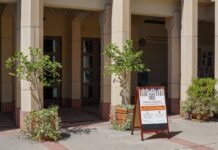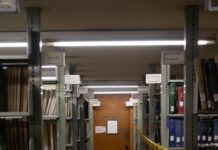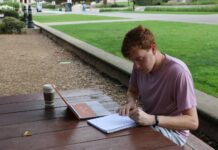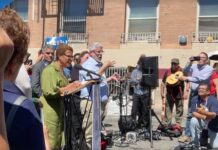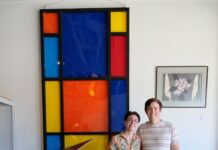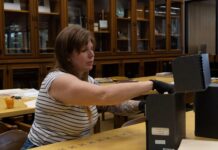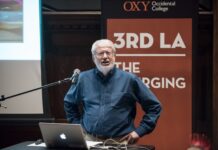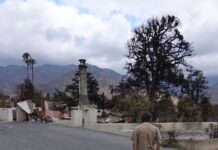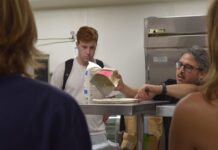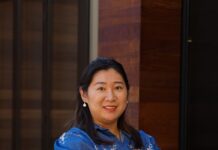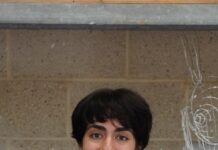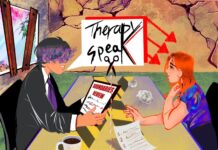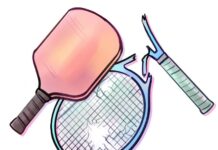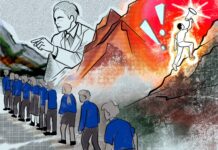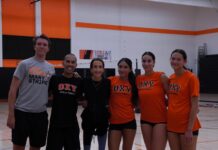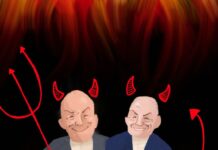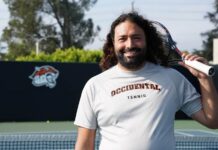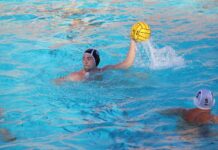One of the benefits of a small, liberal arts college is that students and professors have the opportunity to get to know each other beyond basic facial recognition in a large lecture hall. Many Occidental students take advantage of their small class sizes and meet with their professors in one-on-one settings on a weekly basis, developing individual connections with them. Often, Occidental students become very familiar with the professors who teach classes within their major, and they may even develop a fond, Mr. Miyagi-Daniel LaRusso type of relationship with their academic adviser. Occidental professors are encouraging to students, constantly helping them to grow as scholars and soon-to-be professionals. But what are their lives like once they leave the classroom?
Professor of Art History and Visual Arts Linda Lyke is a Los Angeles artist and professor at Occidental, who specializes in printmaking. At Occidental, she teaches classes such as “Lithography,” “Photo Processes in Printmaking” and “Silkscreen Printmaking.” She has displayed her work in 15 one-person shows and her prints have been featured in 80 national juried print and drawing exhibitions.
Some students might be surprised to learn Lyke is also a nationally-ranked tennis player. Two years ago, Lyke and her daughter decided to start competing in national mother-daughter tennis tournaments. Within a year and a half, the two claimed the No. 1 ranking in the country as a mother-daughter duo. Lyke and her daughter are successful in tournaments played on a variety of surfaces, including grass, clay, hard courts and indoor courts. The two credit their consistent success to their many years of playing together.
“We know each other’s game pretty well, and we keep working on it,” Lyke said.
Lyke mentioned that she has played in the United States Tennis Association league for a long time.
“As you travel, you meet other mother and daughter teams, and you get some really fantastic tennis players,” Lyke said.
Lyke and her daughter also play against other faculty members at Occidental to keep their game sharp.
“We’ve played with them and against them, just for practice. Sometimes we practice with the men’s team, trying to get better,” Lyke said.
When she is not racking up wins on the tennis court, Lyke uses similar skills to create works of art in her studio.
“When you’re playing you have to stay in the moment, and when I’m in the studio, I’m always responding to what’s happening while I’m working,” Lyke said.
Currently on sabbatical, Lyke spends much of her time in her studio working on a series of tracings that depict the anonymous and unethical nature of killings in the Unites States and of drone strikes in other countries.
———-
Every Saturday for the past four years, associate professors Mary Christianakis (Critical Theory and Social Justice, or CTSJ) and Richard Mora (sociology) have gone to a Special Housing Unit (SHU) in central Los Angeles which holds incarcerated youth. In collaboration with the InsideOUT Writers program, these two Occidental professors developed a creative writing curriculum that they teach to a class of young male inmates each weekend. These inmates are minors who will undergo fitness hearings to determine whether they will be tried as adults or juveniles in court.
“To me, it’s one of the biggest civil rights issues in the United States,” Christianakis said. “The system is fundamentally flawed and not rehabilitative.”
Christianakis’ and Mora’s creative writing class at the SHU stems from their passions for issues related to juvenile justice. Over the past four years, their class sizes have ranged from one to 14 inmates per class. Student turnover is common in these classes because of the interference of court dates.
The idea of the InsideOUT program and Christianakis’s and Mora’s class is to use creative writing as a catalyst for personal transformation in order to reintegrate incarcerated youth back into communities. The InsideOUT alumni program also helps formerly incarcerated young people apply to college, obtain jobs and find apartments.
“It’s challenging because there are years of feeling bad and ashamed to overcome,” Christianakis said.
The students have the emotional strains of being incarcerated, having greater literacy needs due to their incarceration.
At least one SHU staff member remains in the room watching the inmates while Christianakis and Mora teach their class. The two teach all types of creative writing to the students. They read Tupac’s poetry while students write their own rap lyrics and letters and explore fictional stories.
As the students learn, Christianakis and Mora also reap the benefits of the class experiences.
“My teaching at Oxy informs my teaching at Central and vise versa. I reflect on my teaching there and I bring that to my classroom at Oxy,” Mora said.
The two are working on expanding the program and making it more accessible.
“[The program is] too small now to have the serious impact that it should have,” Christianakis said.
Both professors are hopeful the collaboration between Occidental and the InsideOUT program will continue to grow.
“Imagine us creating a small institute on our campus with students and alums where we can create academic papers, research projects and documentaries that will have an impact on social policy. I know that Oxy students crave that sort of thing,” Mora said.
Director of the Community Literacy Center and education professor Desiree Zamorano used to teach a class in which Occidental students worked with the InsideOUT Writers program, however, the college chose to discontinue the class. Both Christianakis and Mora hope that Occidental students, as both scholars and social agents, will have the opportunity to participate in the program again in the future.
—-
Ari Laskin was recently named the new Media Arts and Culture assistant professor of Comparative Media Studies. In his three years at Occidental, Laskin’s classes have ranged from digital culture studies to explorations of “mockumentary” film to topics in international cinema. However, Laskin has also been focusing on a myriad of his own film projects.
Recently, Laskin has been working on a book link project that explores the history of infrared and night vision through drones. He is hosting a symposium of military visuality where several theorists will be discussing the U.S. military’s increasing use of drones, which will debut on April 24. He worked on the project for almost five years and even attended a military conference at the Pentagon that dealt with Tier-3 classified drones.
Laskin wants to record a film focusing on research out of UC Berkeley, which mapped cinematized internal thought using MRI machines.
“This is a beautiful cinematic art form with lots of artistic potential as well as theoretical potential. This work is manifested in my art work and theoretical writing,” Laskin said.
Additionally, Laskin is working on directing a feature-length film. It will explore foodie culture and the quest for ethnic authenticity within the hipster blogosphere. The project, which also involves a web-series and user-generated content, will specifically explore Korean dishes Bossam and Samgyupsal. According to Laskin, it will display how the racial notions that circulate contemporary foodie practices are stuck in 19th century: They are fixed as pure and authentic.
“The focus is on a subset of foodie reviewers known as ‘chowhounds’ who are particularly obsessed with uncovering hole-in-the-wall ‘ethnic’ restaurants,” Laskin said via email. “For the chowhound, the ideal eatery is previously undiscovered and serves food in the diasporic region that is nearly identical to that cooked in a home country in the Southern hemisphere. In particular, I am interested in how the notions of race that underlie ‘chowhounds’ search for ethic authenticity assumes that race is something that is fixed, natural, and is pure in its source country.”
—–
When Hurricane Katrina devastated New Orleans in 2005, associate professor of politics Caroline Heldman traveled to Louisiana to cover the aftermath for the local KPFK radio station and contribute to rescue and relief efforts. Early in her career, Heldman worked with an organization called Common Ground Collective to refurbish homes damaged in the hurricane. She then proceeded to open the New Orleans Women’s Shelter with help from Occidental students. The shelter now operates as its own organization and is run by a local resident.
Since then, Heldman has worked to open the Lower Ninth Ward Living Museum – a museum that celebrates the neighborhood – that was virtually wiped off the map of the city of New Orleans after Katrina. Heldman started the project after reading a report on rebuilding in New Orleans and was struck by the lack of effort going into rebuilding the Lower Ninth Ward. With no bills being pushed by local or state politicians to rebuild the neighborhood, it was not going to survive, according to Heldman.
“It became clear to me that there needed to be a place to remember what the neighborhood was like,” Heldman said.
After three years, the Lower Ninth Ward Living Museum opened in August 2013 and currently features events from the history of the Lower Ninth Ward and cultural events to entertain and educate. The museum is an interactive experience that tells the story of the Lower Ninth Ward through the eyes of its residents. Heldman works in New Orleans five months out of the year and even owns the museum building, which also holds volunteer housing. The Living Museum is currently run by two Occidental graduates and several of Heldman’s students fly to New Orleans to live on the volunteer site during breaks.
“The mission of the museum is to remember the past, celebrate the present and plan for the future,” Heldman said.
Heldman hopes that the Living Museum will become the ultimate destination for tourists wishing to learn about what happened to communities in the wake of Hurricane Katrina.
![]()


